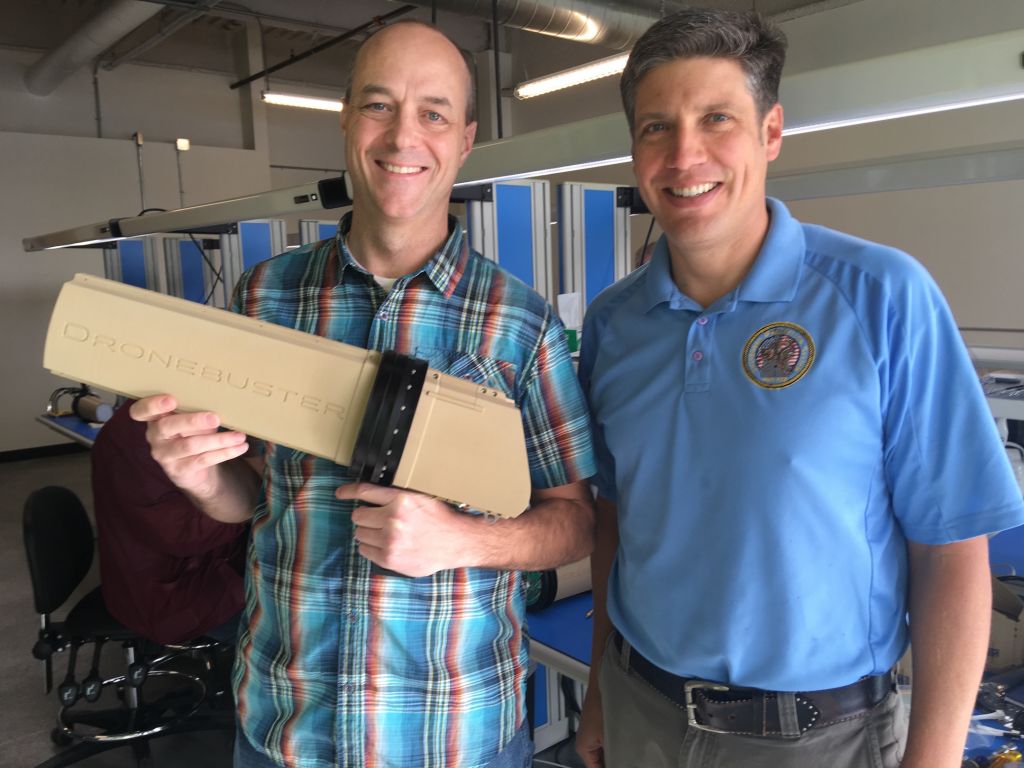In a fourth-floor office overlooking the Pearl District, Jake Sullivan mimed shooting down a drone with a Super Soaker-sized radio frequency jamming gun. He calls the device the “Dronebuster.”
Sullivan kept his finger off the trigger. Squeezing it would jam local Wi-Fi and radio signals protected by FCC regulations.
Sullivan’s two-year-old company, Radio Hill Technologies, supplies the military and federal agents with Dronebusters. The device forces drones to stop and hover. A more powerful setting overwhelms the drone’s GPS signal, making it land or crash.
But without changes to federal regulations, Sullivan said, he’s cut off from 99% of the Dronebuster market: some 16,000 police departments, plus private security and firefighters. Those outlets, he says, could turn his million-dollar company into a billion-dollar enterprise employing hundreds of Oregonians.
“We have good demand from the military,” Sullivan said, “but that’s not what we built it for.”
While futurists eagerly await Amazon drone delivery, first responders sweat the considerable risks posed by unmanned aerial vehicles. Private drones nagged Coast Guard helicopters during Hurricane Harvey. They pestered firefighting aircraft dropping retardant on burns. They’ve smuggled drugs or weapons to prisoners.
“There have been numerous instances of private drones interfering with and even causing curtailment of air operations on wildland fires,” said Tom Zimmerman, president of the International Association of Wildland Fire.
Sullivan, who has a background in physics and optic systems, including stints at defense contractors FLIR Systems and Flex Force Enterprises, came up with a solution: the Dronebuster.
He started Radio Hill Technologies in August 2015 after hearing about consumer drones hampering wildland firefighting aircraft near San Bernardino. Sullivan was tired of defense work, and thought this enterprise would take him in a new direction.
“We looked at this an opportunity to move outside the realm of anything remotely classified or confidential,” Sullivan said, “and immediately got sucked right back into it. “
When he tried to make his first sales to firefighters and police, he learned about legislation that prevents anyone except federal agents from combatting drones.
The Communications Act of 1934, enforced by the FCC, prohibits any attempts to jam radio frequencies.
On top of that, FAA regulations classify even toy drones as aircraft that are protected by a host of international treaties and 18 U.S. Code § 32, which imposes strict penalties for harming, or threatening to harm, an aircraft.
“A private citizen shooting at any aircraft – including unmanned aircraft – poses a significant safety hazard,” Allan Kenitzer, a spokesperson for the FAA said in a statement.
He declined to comment specifically on Radio Hill’s technology, which topples drones without firing projectiles into the air.
So Sullivan found himself back in the defense business. Radio Hill has filled Dronebuster orders for the Air Force, the Department of Defense, the Army and foreign governments (Sullivan wouldn’t disclose which ones).
“I’m fairly confident they’ve been used and been successful,” Sullivan said, “The products go down range, and they [the military] come back and order more.”
One potential military application of the Dronebuster is thwarting drone-delivered IEDs. As these weapons gain popularity with ISIS and other terrorist groups, the military sees the Dronebuster as the only combat-ready solution.
Beginning this January, Radio Hill’s revenue multiplied 100 times over, from $78,000 to around $7.8 million. The company employs about 10, and relies on around 50 subcontractors.
Source: Oregon Business



Also mind that 47 USC 333 prohibits interference with licensed/authorized radio frequencies.